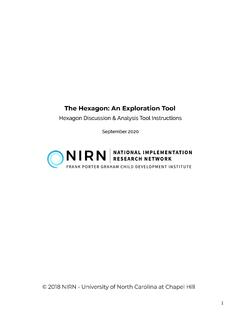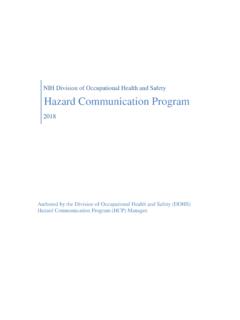Transcription of Implementation Stages Planning Tool - NIRN
1 Implementation Stages Planning Tool 2020 NIRN 2020 NIRN2 Implementation Stages Planning Tool InstructionsWhether using something new, scaling an established program or practice or supporting an initiative comprised of multiple programs and practices, successful Implementation takes intentional Planning and time. Implementation is not an event but a process involving multiple decisions and actions. Change at the site, local, community or state level resulting in improved outcomes does not occur all at once. Although Implementation can take longer than we hope or anticipate, its process and trajectory can be predicted and shaped using a stage-based happens in four discernible Stages :EXPLORATION Exploration involves an assessment of assets and needs of the focus population, fit of the program or practice with those needs and assets and feasibility of Implementation .
2 INSTALLATION Installation involves building the infrastructure necessary to implement the program or practice, which includes building practitioner and organizational Implementation Initial Implementation includes the initial efforts of staff to use the program or practice, with attention to using data for continuous Implementation Full Implementation occurs as staff use the program or practice successfully, and population-level outcomes are Citation: National Implementation research Network (2020). Implementation Stages Planning Tool.
3 Chapel Hill, NC: National Implementation research Net-work, FPG Child Development Institute, University of North Carolina at Chapel document is based on the following: National Center for Early Childhood Development, Teaching, and Learning (2019). Early Childhood Specialists Active Implementation Toolkit. Devel-oped with funds from Grant #90HC0012 for the Department of Health and Human Services, Administration for Children and Families, Office of Head Start and the Office of Child Care by the National Center for Early Childhood Development, Teaching and Learning.
4 National Implementation research Network (2013). Stages of Implementation Analysis: Where are we now? Chapel Hill, NC: National Implementation research Network, FPG Child Development Institute, University of North Carolina at Chapel Hill. Copyright 2020 National Implementation research Network at the University of North Carolina at Chapel HillThis content is licensed under Creative Commons license CC BY-NC-ND, Attribution- Noncommercial-NoDerivs. You are free to share, copy, distribute and transmit the work under the following conditions: Attribution You must attribute the work in the manner specified by the author or licensor (but not in any way that suggests that they endorse you or your use of the work); Noncommercial You may not use this work for commer-cial purposes; No Derivative Works You may not alter, transform, or build upon this work.
5 Any of the above conditions can be waived if you get permission from the copyright 2020 NIRNI mplementation Stages Planning ToolAs an Implementation team or as an individual:1. Identify the program or practice s Implementation stage to be assessed. 2. Use the flow chart to determine the stage of Go to the identified stage s activities and expected For each activity within that stage, check whether the activity is: In Continuous Improvement, In Progress, or Not Yet For each stage, check the outcomes accomplished. 6. Use the notes box to capture reflections, needed actions, Review previous and future stage activities and expected outcomes to identify improvements needed or Planning Use the assessment results to build Implementation plans, define a scope of work for an Implementation team, and communicate progress with staff and TO USEWHEN TO USEThe Implementation Stages Planning Tool can be used at any point in the Implementation process.
6 For example, the tool can be used when considering adopting or initiating a new program or practice to guide the selection process and, if needed, the Implementation work. It can also be used during the Implementation process to identify next steps or, should Implementation falter, evaluate potentially missed activities. The tool will help your team and organization ensure Implementation activities match the current stage of Implementation and support moving into subsequent Stages of Implementation . It is important to note that Implementation Stages do not always end as the next begins; Stages often overlap, and activities can cross Stages .
7 There also may be instances in which an organization is in different Stages at the same time for different programs/practices. In addition, activities necessary for sustainability are embedded within each the current stage of Implementation for a program, practice or initiative can help staff and stakeholders to better understand progress, ensure the use of appropriate Implementation strategies for that stage, plan for data collection and usage, and communicate current Implementation efforts. The Implementation Stages Planning Tool supports identification of the current stage and Implementation Planning and improvement by providing a flow chart to determine the current stage of Implementation , a list of appropriate stage-based activities, and an outline of expected stage-based outcomes.
8 2020 NIRN4 Follow the Implementation Stages Flowchart to determine what stage of Implementation a program or practice is in currently by following the arrows and answering simple yes or no questions. Implementation Stages FLOWCHARTS tart the organization selected a practice to implement?Is the organization considering implementing a new practice?Have staff ( , education staff ) already started implementing the new program or practice?Are the majority of staff implementing the new program or practice with fidelity?The organization is in INITIAL IMPLEMENTATIONThe organization is in INSTALLATIONThe organization is in EXPLORATIONThe organization is in FULL IMPLEMENTATIONYesYesYesYesNoNo5 2020 NIRNI mplementation Stages Planning ToolIMPLEMENTATION Stages CHECKLISTE1.
9 Grow relationships with stakeholders with a variety of diverse perspectives and inclusive of voices not traditionally Develop an Implementation Team representative of the staff, organization and community that are the participants in and recipients of needed Cultivate Sponsors/Champions that have the authority and cultural capital to promote Assess and create readiness for team, staff, and Identify changes needed, existing assets, and potential root Scan or assess what is currently in place to address the change needed (Initiative Inventory).
10 E7. Identify and learn about other potential practices or programs to address the change Assess fit and feasibility of options to address the change needed. Consider need, fit, evidence, usability, capacity, and supports (Hexagon Tool) . E9. Using fit and feasibility assessment results, identify the option to implement, or choose to reassess need and potential options, or choose not to STAGE ACTIVITIESA ssess your team s progress within important stage-based activities for your current stage of Implementation . Once you have done so, review progress within previous or subsequent Stages to identify improvements and/or Planning needs.






